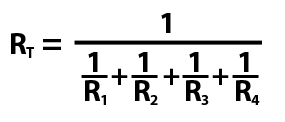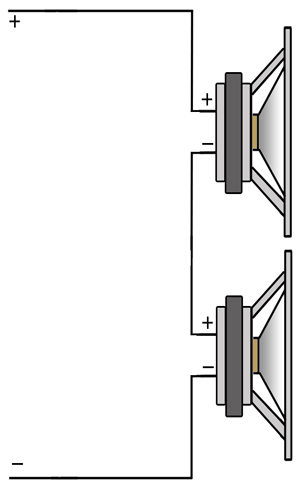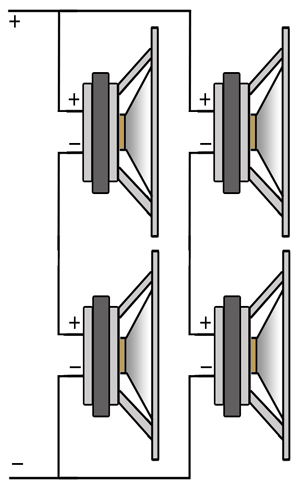Impedance – FAQs
How do I know what impedance load I have?
Most manufacturers will specify impedance, and will include it in the product specifications, often printing it on the speaker itself. If you don’t have this information, you can measure the DC resistance using a multi-meter (please note Resistance is NOT Impedance – find out why here: https://speakerwizard.co.uk/impedance-and-resistance-whats-the-difference/
You should only measure the resistance of speakers when they are not in use, and not connected to an amplifier. By putting your multi-meter probes on each terminal of the speaker you will get the DC resistance, which can be used as a guide to get the impedance. A DC resistance of 5-6 ohms is normal for a driver with 8 ohm impedance, around 12-13 ohms is common for a 16 ohm impedance driver, and 3 ohms DC resistance would be normal for a 4 ohm impedance. You may notice that moving the cone whilst checking the resistance will make the reading change, this is because the voice coil is moving in a magnetic field, which will induce a voltage in the coil, which in turn will affect the multimeter’s measurement.
Many loudspeaker manufacturers will label the drivers to make identification easier, Eminence for example include a suffix on the drivers, for example the Beta12A is the standard model, and is 8 ohm impedance, the letter A designated 8 ohm impedance. The Beta 12B is 16 ohm impedance, and the Beta 12C is 4 ohm impedance. This same letter designation is used through the range of Eminence speakers.
I have more than one speaker in parallel – what’s the impedance?
First, let’s clarify what we mean by parallel, this is where the electrical paths through the drivers from + to – run in parallel to each other. If you trace a route from + to – you go through either one driver, or the other. The diagram below shows two speakers wired in parallel:
To wire speakers in parallel, all you have to do is connect the + (positive or red terminal) on each speaker to the + (positive or red terminal) on your amplifier, and the corresponding – (minus or black terminal) on the speaker to the – (minus or black terminal) on your amplifier. If you plug several speakers into one amplifier, unless you have unusual cabling, this would be the standard way you would run several speakers off one amplifier.
Its normal to put speakers of the same impedance in parallel with each other, mismatching impedances isn’t a great idea unless you have a fairly advanced knowledge of speaker systems and are doing this for a specific purpose.
So what does this do to the impedance?
The impedance of each speaker stays the same, but the impedance load the amplifier sees will change. In the diagram above, if the two speakers were both 8 ohm impedance, the load the amplifier would see is 4 ohms. To think of this in simple terms, you could think of one loudspeaker as a busy road with a specific amount of traffic travelling along it, if you have two roads, the traffic can travel along either road, which presents less ‘resistance’ to the same amount of traffic. With a basic knowledge of maths, and using this analogy of two routes between start and finish, you can guess what the resistance of two parallel 8 ohm drivers would be, it’s half that of one 8 ohm driver, and is 4 ohms.
The formula for calculating parallel resistances is as follows:
R1, R2, R3, are the individual resistances, the formula works for as many, or as few resistances there are in parallel, for two drivers in parallel, you use R1 and R2 only, for three drivers you use R1, R2 and R3.
RT is the total parallel resistance. For equal parallel resistances, the formula becomes very simple, as the table of parallel 8 ohm impedances shows:
| No drivers | Parallel Impedance | Fraction |
| 1 | 8 ohms | 1/1 |
| 2 | 4 ohms | 1/2 |
| 3 | 2.6 ohms | 1/3 |
| 4 | 2 ohms | 1/4 |
| 5 | 1.6 ohms | 1/5 |
| 6 | 1.3 ohms | 1/6 |
As you can see, 3 drivers gives a combined parallel impedance of one third of the original impedance of 8 ohms, and 4 drivers gives a combined parallel impedance of one quarter of the original impedance.
Very few amplifiers will run happily into impedances below 2 ohms, and there is a strong possibility you can damage the amplifier by plugging too many speakers into it. Some amplifiers will not work safely below 4 ohms, so it’s quite important to ensure you have the correct load on your amplifier.
How do I wire speakers in series?
The term series where things are arranged in sequence implies how you would arrange speakers in series, as per the diagram below you can see that the positive (+) terminal of the first speaker is connected to the positive (+) of the amplifier as normal, but the negative (-) terminal goes the the positive terminal of the second speaker. The last speaker in the series has it’s negative (-) terminal connected to the negative (-) terminal of the amplifier.
Series impedances work opposite to parallel, going back to the comparison with traffic, if your busy road has traffic lights in it, every extra set of traffic lights adds more resistance to traffic flow. In the same way, each loudspeaker in series adds to the impedance. To calculate the total impedance, simply add together the individual impedances, as shown in the table below. In most instances, its rare to have more than 2 drivers wired in series, as the increase in impedance will mean most amplifiers are able to deliver very little power to the drivers.
| No drivers | Series Impedance |
| 1 | 8 ohms |
| 2 | 16 ohms |
| 3 | 24 ohms |
| 4 | 32 ohms |
If we get less power, what’s the point of connecting drivers in series?
If you just have one pair of speakers, there isn’t much point, but it gets interesting when you have multiples of speakers. If for example you have four speakers, that are 8 ohms, and you want to run all four speakers off one amplifier, you could wire all four in parallel, to give a 2 ohm load, or all 4 in series to get a 32 ohm load. But what if your amplifier wont work below 4 ohms?
The solution is simple, a series-parallel combination:
Assuming all drivers are 8 ohms, some simple maths and you can see that each of the two series combinations has an impedance of 16 ohms. Two 16 ohm impedances in parallel have an overall impedance of 8 ohms. What this allows you to do is use four speakers where you would previously have only used one, giving you a significant increase in power handling.
Variations of series-parallel configurations are common in guitar speakers, 4 x10″ and 4 x 12″ cabinets are common, with different wiring to suit specific applications and impedance requirement. Many guitar cabinets utilise 16 ohm drivers in order to achieve the desired results.
Its sometimes advised that its best to avoid using series configurations with speakers, due to the fact that that you have two coils or inductors which can induce unwanted voltage and cause distortion. Series configurations are rarely used in hifi or studio systems.
One Comment
Leave a Reply
You must be logged in to post a comment.




Monday, August 28th 2017 at 01:44 |
[…] A: NO. The power rating of your amplifier is a measure of how many watts it can deliver to the speakers before it reaches the limitations of its internal power supply and starts to clip/distort. The power rating of your speakers is the maximum power they can accept from an amplifier before they are in danger of overheating and burning out. Providing you have the corrent impedance load, your speakers are unable to draw more power than the amplifier is willing to give. https://speakerwizard.co.uk/impedance-faqs/ […]